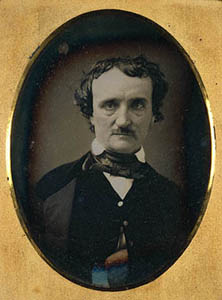• This portrait is a daguerreotype. How is a daguerreotype different from other types of photographs you might have seen?
• Think about the last time you had your photograph taken. How long did it take? The exposure time for a daguerreotype in 1849 took about 10 seconds. Have the class sit and hold a pose for 10 seconds. How does it feel to hold a pose that long? Is it difficult?
• Look at Poe's facial expression. What does it seem tell us about how he was feeling when this portrait was made?
• Do you think the long exposure time for a daguerreotype had any effect on Poe's portrait? If so, how?
• Poe said of this portrait, "My life seems wasted—the future looks a dreary blank." Do you agree or disagree with his opinion of his portrait? Why?
• Annie Richmond was critical of this portrait of Poe, saying that the image "does not do him justice...his face was thin... & his features heavy, which makes it seem almost like a caricature—yet, he certainly sat for it, & the artist (if he deserves the title) is still living here, who had the privilege of taking it." In Annie's statement, it is implied that the artist is at fault for the result of Poe's portrait. What is the role of the artist when creating someone's portrait? How much of an effect do you think the photographer had on the outcome of Poe's portrait?
|
Edgar Allan Poe is considered one of America's great literary figures. While he is best known for his poems and short fiction, he is also credited with the creation of the modern detective story and with perfecting the psychological thriller. His writing was renowned for its sense of mystery and the macabre, and his equally dramatic life was peppered with rumors of alcoholism and other illness and marked by early poverty and tragedy.
This portrait, one of eight daguerreotypes known to exist of the author, was made at the request of Annie Richmond, a woman with whom Poe fell in love following his wife's death in 1847. Richmond is thought to have arranged for the portrait sitting and to have paid for the photograph. A local photographer in Lowell, Massachusetts, made this portrait of the famed author just four months prior to his death. In the portrait, Poe's haunted eyes and disheveled hair reveal the potential for volatile emotions.
About the Process
The daguerreotype, invented by Louis Jacques Mandé Daguerre in 1839, became the first popular photographic medium. A one-of-a-kind, highly detailed image on a silver-plated copper sheet, the daguerreotype was a unique original—there was no negative from which multiple prints could be made.
Daguerreotypes were wildly popular in America and their makers created thousands of images, many of which were portraits, until about 1855, when a faster and less expensive photographic process became available. Daguerreotypes, however, were not without their inconveniences: exposure times were initially several minutes and sitters had to remain still, often held in place by awkward clamps and stands. Furthermore, they could be expensive: in 1850s America a daguerreotype could cost anywhere from 25 cents up to 50 dollars.
The highly polished, reflective surface of the daguerreotype was susceptible to damage from abrasion and tarnishing, so daguerreotype plates were protected by a mat and a glass cover. Paper tape was folded around the edge of the plate, mat, and glass and fitted into a book-like case made of wood-covered leather or an early form of plastic. The most common size of daguerreotype, called a sixth plate, measured about 2 3/4 x 3 1/4 inches (7 x 8.3 cm).
|
